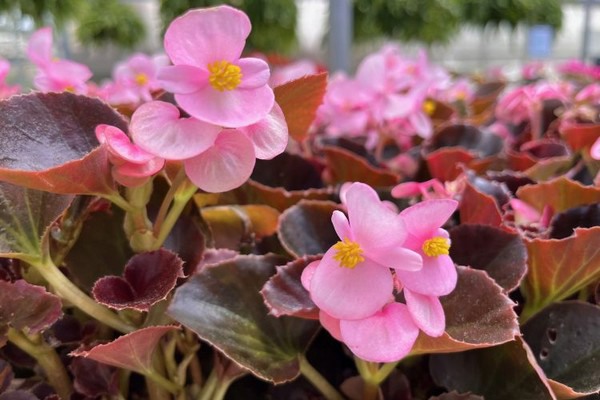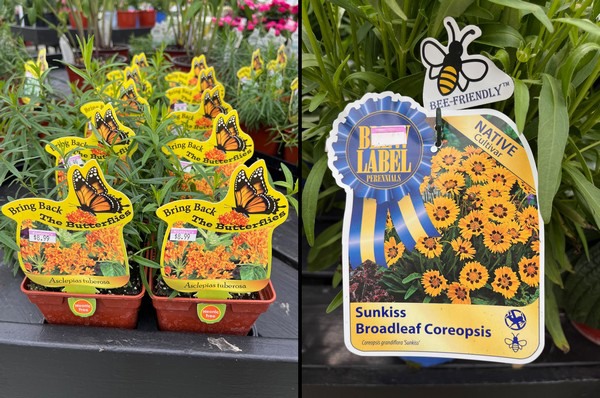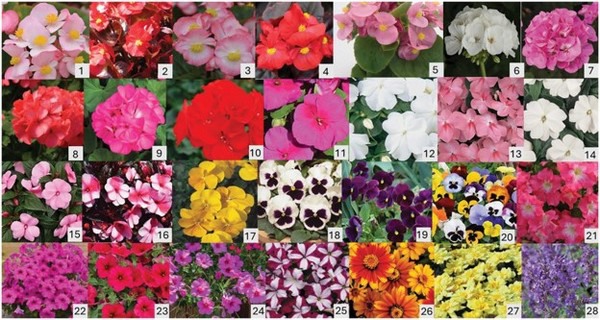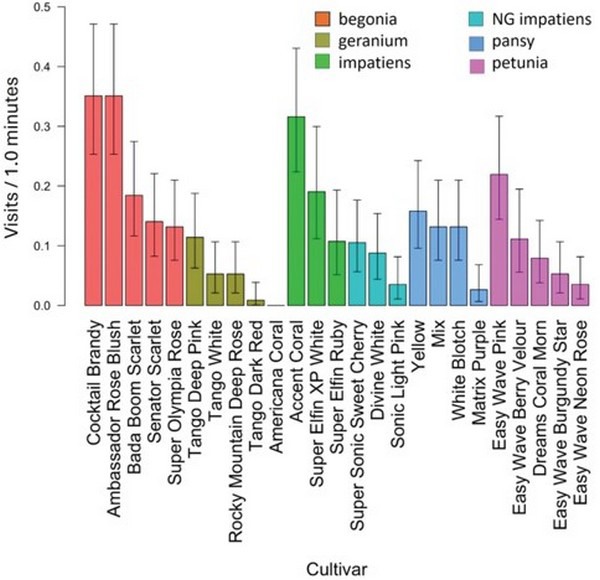There is a wide variation in pollinator attractiveness in the most popular annual bedding plants.
 Photo 1. 'Cocktail Brandy' begonia drew among the most pollinator visits of the 25 plant varieties tested in a recently published study. Photo by Heidi Lindberg, MSU Extension.
Photo 1. 'Cocktail Brandy' begonia drew among the most pollinator visits of the 25 plant varieties tested in a recently published study. Photo by Heidi Lindberg, MSU Extension.
Pollinator health has been a topic at the top of people's minds over the last few years. Numerous studies have shown that consumers are interested in bee-friendly plants and pest management practices and are willing to pay a premium for plants grown with bee-friendly practices. Plant marketers have responded to these findings by creating flashy point-of-sale tags for plants well-known to be highly attractive to pollinators including butterfly weed (Asclepias) and Coreopsis (Photos 2 and 3).
 Photos 2 and 3. Point-of-sale labels showing value of butterfly- and bee-friendly perennials in a garden center. Photos by Heidi Lindberg, MSU Extension.
Photos 2 and 3. Point-of-sale labels showing value of butterfly- and bee-friendly perennials in a garden center. Photos by Heidi Lindberg, MSU Extension.
Dave Smitley, professor emeritus of entomology, recently published a study that looked at pollinator visits of three to six cultivars of the six most popular annual plant species: petunia, impatiens, begonia, geranium, pansy and New Guinea (Photo 4). These plant species account for up to 50% (over $900,000 in sales) of yearly sales in the U.S. Smitley and his team compared the number of pollinator visits among the popular plant species to two annual flowers and two perennial flowers known to be pollinator attractive: zinnia 'Zahara Sunburst,' marigold 'Alumia Vanilla Cream', catmint 'Walker's Low' and coneflower 'Pow Wow Wild Berry'.
 Photo 4. Twenty-five different plant cultivars and the pollinator benchmark standards evaluated in the study. Photo by Smitley et al., 2024.
Photo 4. Twenty-five different plant cultivars and the pollinator benchmark standards evaluated in the study. Photo by Smitley et al., 2024.
While many cultivars of the most popular annual flowers were not very attractive to pollinators compared to the benchmark annual and perennial species, there were a few that were moderately attractive to pollinators, including begonia 'Cocktail Brandy' (Photo 1), begonia 'Ambassador Rose Blush', impatiens 'Accent Coral' and impatiens 'Super Elfin XP White.'
 Photo 5. In 2018, mean pollinator visits per minute for the entire 2018 growing season for all pollinator groups combined. Source: Smitley et al., 2024.
Photo 5. In 2018, mean pollinator visits per minute for the entire 2018 growing season for all pollinator groups combined. Source: Smitley et al., 2024.
There was great variation in pollinator attraction between cultivars even within species, (Photo 5). For example, begonia 'Cocktail Brandy' had over double the pollinator visits compared with begonia 'Super Olympia Rose.' The cultivars that were most attractive to pollinators would benefit from the added value of labeling them as bee-friendly. For more information, check out the press release, "Some varieties of annual flowers have a place in pollinator-friendly gardens."
Source: canr.msu.edu
